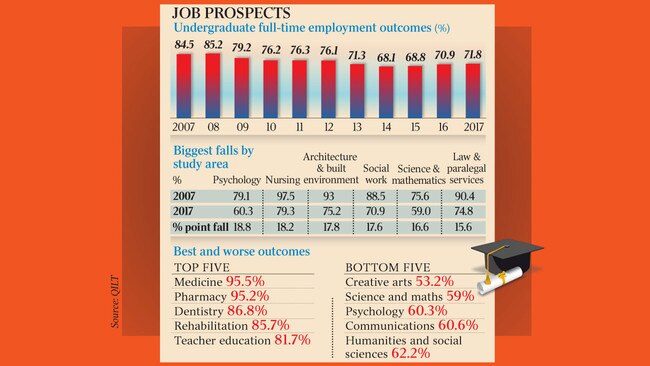Employment prospects ‘best in five years’ for vocational university graduates
University graduates are enjoying the strongest employment market in five years.
University graduates are enjoying the strongest employment market in five years, according to federal government data due to be released today.
The Graduate Outcomes Survey shows that the full-time employment rate for graduates rose nearly one percentage point to 71.8 per cent compared with a year earlier, and the median graduate salary rose 3.6 per cent to $60,000.
Discipline areas in most demand include medicine (with a full-time employment rate of 95.9 per cent), pharmacy (95.2 per cent) and dentistry (86.8 per cent), but full-time work is hardest to find for graduates in the creative arts (53.2 per cent full-time employment rate), science and maths (59 per cent) and psychology (60.3 per cent).
The figures, which report the experience of students who graduated from bachelor degree courses in 2016, are good news for the latest crop of graduates entering the job market.
The survey of more than 100,000 students also found that the salary gap between men and women graduates was the smallest recorded, with women earning a median salary of $59,000, 1.9 per cent less than the male graduate median of $60,100.

Even so, women graduates continue to earn less than men in most disciplines with the exception of engineering, where women earn a median $65,000 compared with men’s $63,500, and communications, where both genders earned a median of $50,000.
Despite recent improvements in job prospects, graduates still face a worse employment outlook than a decade ago, when it was easy to find jobs before the global financial crisis hit.
In 2007, the full-time graduate employment rate (which measures the number of graduates with full-time jobs as a proportion of the number available for full-time work four months after graduation) was 84.4 per cent, compared with 71.8 per cent now.
The fall in full-time jobs for graduates has been partly compensated by more part-time work opportunities.
The overall graduate employment rate (including part-time jobs) for students was 86.5 per cent last year. While this is less than the 94.9 per cent rate in 2007, the fall in graduate employment is not as large when part-time jobs are taken into account.
Federal Education Minister Simon Birmingham urged students starting university this year to use the figures, published on the government’s Quality Indicators in Learning and Teaching website, to “do their homework” on their planned course: “It’s important students take time to consider their options before taking the plunge.” Senator Birmingham said the figures clearly showed graduates from vocationally oriented courses were more likely to get full-time jobs than students with generalist degrees.
Acting chief executive of the university peak body Universities Australia Catriona Jackson said the improving employment market for graduates made it hard to understand why the government announced cuts to university funding late last year.
The survey also found 79.4 per cent of graduates were satisfied with their university course, down from 80.6 per cent a year early, but only 63 per cent of students were satisfied with the quality of teaching in their course.



